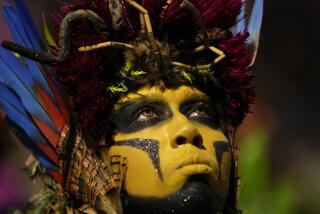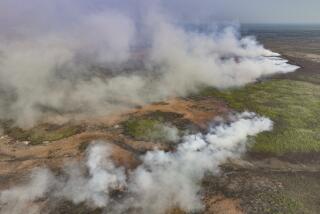Manaus is Brazil’s jewel of the Amazon jungle
MANAUS, Brazil — It’s that special time in the late afternoon when the light turns golden and life seems to move at the pace of a bygone era in the square that anchors this Amazon city’s opera house.
Children clamor to catch soap bubbles sent aloft by a vendor, tourists pedal by the African House on three-wheeled bikes as patrons sample juice made from the fruits of the rain forest, and the stand in the corner of the plaza turns out bowl after bowl of steaming tacaca soup.
If there’s one square that encapsulates all that makes Manaus special, it’s the Largo de S’o Sebasti’o. The architecture, culture, cuisine and history of the Amazon are all on display in this historic district near the Port of Manaus.
Entering the pink opera house with its neo-classical and Greco-Roman flourishes is like stepping back into the 19th century when the rubber industry made Manaus Brazil’s golden city the richest in the entire country.
It was a time when the “aroma of rubber perfumed the air,” when women sent their gowns out to be laundered in Portugal, the best opera companies in the world visited and rubber barons lit their cigars with currency, says Roberio Braga, secretary of culture for Amazonas, the largest state in Brazil but one of the most sparsely populated.
But like a candle in the wind, Manaus burned so brightly only briefly, from 1879 to 1912. Then the rubber industry sputtered out, after rubber tree seeds were smuggled out of Brazil and planted by the English in Malaysia, Sri Lanka and British colonies in Africa. When England undercut Brazilian rubber in the world market, Manaus fell on hard times.
The famous opera house was shuttered for decades. “We had a very poor period. Everything was devalued,” Braga said.
But the renovated opera house is once again a cultural hub, home to the Amazonas Symphony Orchestra and open for guided tours and performances, including some that are free. And Manaus is once again hoping for a star turn when it hosts four World Cup games from June 14 to June 25, with the United States playing Portugal on June 22.
“This is a special opportunity, so we must take advantage of it. This is not so much a financial windfall, but an opportunity to promote our state” and cement its reputation as a cultural and tourism center, Braga said.
There’s plenty to see in Manaus starting with the Teatro Amazonas (Avenida Eduardo Ribeiro). Finished in 1896, it boasts a dome with 36,000 pieces in the colors of the Brazilian flag, the original painted stage curtain imported from Paris, and a driveway made of rubber that muffled the sounds of horses and carriages during a performance.
The Murano crystal chandeliers were imported from Italy, the pine floors noted for their acoustic properties came from Lithuania, the gilded mirrors were sent across the ocean and up the Amazon from France, and the furnishings brought in from France and Italy. And if you crane your neck toward the ceiling, the view mimics what you would see if you were looking up from under the Eiffel Tower.
The S’o Sebasti’o church, whose bells toll on the quarter hour, sits on the opposite corner from the opera house, and it’s worth popping in if you’re in the neighborhood.
Around the square are bars where tables are drawn out on the sidewalk and patrons take their time nursing ice-cold bottles of beer, restaurants that serve freshwater fish from the Amazon. At art galleries, cafes and souvenir shops, you’ll find dolphins and monkeys carved from exotic woods, woven baskets and jewelry crafted by indigenous groups.
Familia Sulaiman, Rua 10 de Julho 603 has a good selection of handicrafts and good prices. For high-quality items, try nearby Galeria Amazonica, Rua Costa Azevedo 272.
The weather in Manaus is tropical, so after you’ve finished your tour of the opera house, stop by Sorvete Glacial for cones or scoops of ice cream that you buy by the weight. My favorite combo was acai made from the berries of the acai palm, maracuja (passion fruit), and cupuacu a custardy white fruit that tastes a bit like pineapple meets chocolate meets apple.
Though it sounds counter-intuitive to drink a hot soup on a steamy day, don’t leave Largo de S’o Sebasti’o without stopping by Tacaca da Gisela for a spicy concoction of mandioca broth, tapioca paste, the lip-numbing jambu leaves and dried shrimp.
Mix it all together and you have tacaca, a signature dish of the Amazon. The curious melding of tang, tartness and briny shrimp is flavor heaven. It’s served in the waterproofed shell of a gourd with a little wooden pick to stab the shrimp and jambu.
Walking across the black and white mosaic tiles of S’o Sebasti’o square will put you in the mood for another must-see attraction. The wave-like patterns represent the Meeting of the Waters.
Just east of Manaus, the Rio Negro joins the Rio Solim’es (the name given the Amazon River around Manaus and west to the Peruvian border) but when the two rivers meet, they don’t mingle.
Like neighbors who can’t get along, the Rio Negro, which looks like black tea due to decomposing material, and the muddy brown Solim’es keep to themselves for nearly four miles before they finally mix and flow on as the mighty Amazon.
The striking demarcation between the two results when the slower, warmer Rio Negro meets the faster, colder Solim’es, whose headwaters are in the Andes. Differing water densities slow the mixing process too.
Tours of the Encontro das Aguas are available by both air and water.
No trip to Manaus is complete without putting in some time on the Amazon and its tributaries, which are so essential to this region’s way of life. Though Manaus itself is a bustling metropolis set up on a grid with good bus connections, there are few roads outside the city.
Long narrow motorized boats, the lanchas rapidas, are the taxis of the Amazon; kids who live along the rivers take school boats not buses. Tour operators will arrange visits to Amazon families where you can learn how they live on the river.
Manaus is also a convenient jumping off place to the world’s largest tropical rain forest, and many Amazon tour operators and outfitters are clustered in the side streets near Largo de S’o Sebasti’o.
I had long heard stories of the pink freshwater dolphins of the Amazon but I had my doubts about how pink they really were. The ones I saw at a rustic floating dolphin attraction at Acajatuba Lake were a delightful rosy hue. Even though it was pouring rain, seeing these creatures was one of the high points of my trip.
A dolphin encounter is an easy day trip from Manaus and you’ll see the flooded jungle that reminded me of Florida’s Ten Thousand Islands, sans mangroves, where ceiba and other trees have acclimated to the fluctuating water levels of the rivers and the high-water marks reaches far up on the stilt homes along the edge of the Rio Negro.
You’ll also enjoy a trip through the Anavilhanas Archipelago a labyrinth of small islands in the Rio Negro where you’ll catch sight of manatees, jacanas whose yellow flight feathers look like fluttering butterflies, and monkeys.
Some of my other favorite spots:
Museu Do Homem Do Norte and Centro Cultural dos Povos da Amazonia, both at Praca Francisco Pereira da Silva: With 2,000 pieces in its collection, the Museum of the Northern Man showcases the culture, dress, cuisine, customs and products of the Amazon region. You’ll learn that some of the baskets on sale at the souvenir shops are actually fish traps and that Brazil nuts come 20 to 30 to the husk. There’s also a replica of the maloca, a Arawak longhouse with the tools and implements traditional people use for hunting, fishing, trapping and cooking.
Nineteen bronze life-size figures by sculptor Felipe Lettersten also are on display in the Sons of Our Land (Os Filhos da Nossa Terra) exhibit at the cultural center. Native people, many of whom are still reluctant to be photographed, allowed Lettersten to cover their bodies in gesso to form the molds for the life-size statues.
The Adolpho Lisboa Municipal Market, Rua dos Bares 46, Centro: Adorned with art-nouveau iron work and stained-glass eyebrow windows, this market, which dates to 1883, sells everything from fresh meat, fish and mounds of dried shrimp to exotic Amazon medicinal herbs, bottles of tucupi sauce, native basketry, carvings and other handicrafts.
Lake Janauari Ecological Park: Elevated pathways, with Capuchin monkeys scampering overhead in the tree canopy, take you from lakeside to this 9,000-acre park where you’ll see giant water lilies that look like they’re on steroids. Some are as much as seven feet in diameter, and their flowers bloom white, pink and purple in rapid succession before dying. You’ll see the flooded forest, alligators, and an abundance of birds. It’s a great place to get a taste of the Amazon if you don’t have time for an extended trip on the river.
A floating restaurant is anchored near the park entrance during the wet season and it’s fun to arrive by boat and sample the buffet, which includes several types of Amazon fish and other regional cuisine.
IF YOU GO:
WHAT TO EAT: The food of the Amazon is influenced by Indian, African and Portuguese cuisine and also the fruits and spices of the rain forest. You could spend an afternoon sampling tropical juice. Try acai and cupuacu to get started. Don’t leave Manaus without trying tacaca the spicy soup or the coconut milk and shrimp dishvatapa, sampling Amazon region fish such as arapaima (also known as pirarucu), tambaqui and tucunare (peacock bass), slathering yellow tucupi sauce on your fish or duck or sampling some guarana tea.
For taxi rates, phone numbers and other information on World Cup host cities:https://www.copa2014.gov.br/en/servicos
The electrical plugs are different in Brazil. Though Manaus operates on 110 volts, most of the sockets are Type C and D and won’t work with the typical two-pronged plug of the U.S. Most hotels provide adaptors, but it’s best to take your own if you want to make sure your small appliances will work.
MONEY EXCHANGE: Parmetal, Rua 10 de Julho 651 in central Manaus near the opera house offers good rates.
AFTERNOON BREAK: Between 1-2 p.m. many stores, offices and even restaurants are closed.
WHERE TO STAY:
Boutique Hotel Casa Teatro: Rua Dez de Julho, 632; 011-55-92-3633-8381; https://www.casateatro.com.br/english/. Located in the center just a half-block from the opera house, it has a rooftop terrace with scenic views of downtown. The place is packed with eclectic collections and interesting art objects and antiques. Its suites are quite small but have everything you need: mini-fridge, air-conditioning, large showers, safe and small flat-screen TV. But the odd up-and-down layout and steep staircases (no elevators) don’t make this a good candidate for those with mobility problems. Little availability during June; after June 29, $63 for a twin with shared bath to $72 for two people in a suite (includes VAT).
Hotel Tropical Manaus: Avenida Coronel Teixeira, Ponta Negra; 011-55-92- 2123-5000; tropicalmanaus.com.br. The Ponta Negra area boasts a sandy beach along the Rio Negro. It’s reminiscent of Miami’s Brickell neighborhood with its condo towers. It’s also home to the Hotel Tropical Manaus. It’s quite isolated about 30 minutes outside the city center but the hotel has a mini-zoo, tennis and beach volleyball courts, pools, hiking trails, an archery range, spa and a launch area for seaplanes. While Brazilian breakfasts are generally ample, this place leaves others in dust: carrot cake, passion fruit cake, tapioca cake, omelet bar, fish stew, fried bananas sprinkled with cinnamon, and a stunning array of cereals, meats, cheese, breads, and tropical fruit and juices. Rates start at $165 plus taxes for a double standard room after June 29.
Amazon Ecopark Jungle Lodge: Taruma Acu River, Tarum’; 011-55-21-3005-5536; https://www.amazonecopark.com.br. To get a taste of the jungle without being too far from the city, try this eco-lodge a half-hour trip by boat up a tributary of the Rio Negro and an hour from the airport. It offers excursions such as a rain forest walk, night-time caiman spotting, and a visit to a monkey sanctuary. You’ll sleep in charming, rustic bungalows and dine in a thatched roof pavilion. The hotel is even offering a World Cup package that promises to get you from jungle to the stadium in an hour via boat and special bus. Enjoy soccer matches in the city and then fall asleep to the sounds of the rain forest, says the manager. At press time, there were still some rooms available during World Cup month: $196-$257. After June 29: $124-$163 for a bungalow.
Mimi Whitfield: [email protected]
(c)2014 The Miami Herald
Visit The Miami Herald at https://www.miamiherald.com
Distributed by MCT Information Services
PHOTOS (from MCT Photo Service, 202-383-6099):
WLT-BRAZIL-MANAUS
More to Read
Sign up for The Wild
We’ll help you find the best places to hike, bike and run, as well as the perfect silent spots for meditation and yoga.
You may occasionally receive promotional content from the Los Angeles Times.






